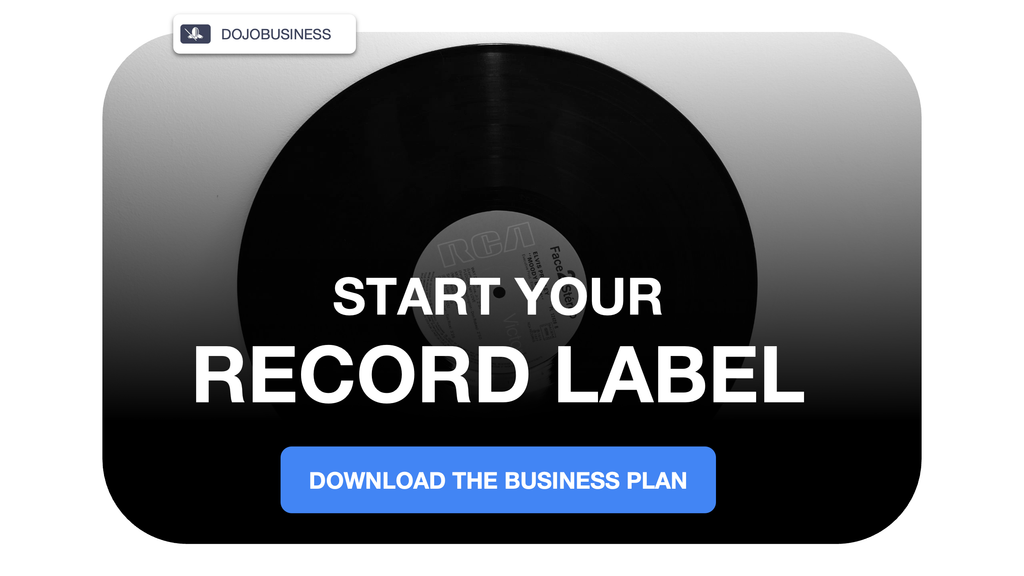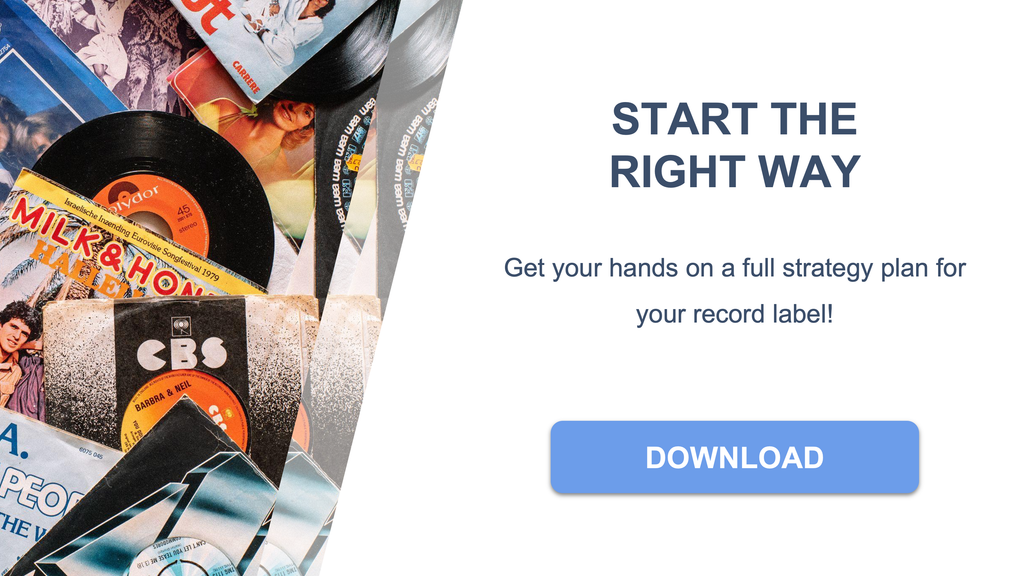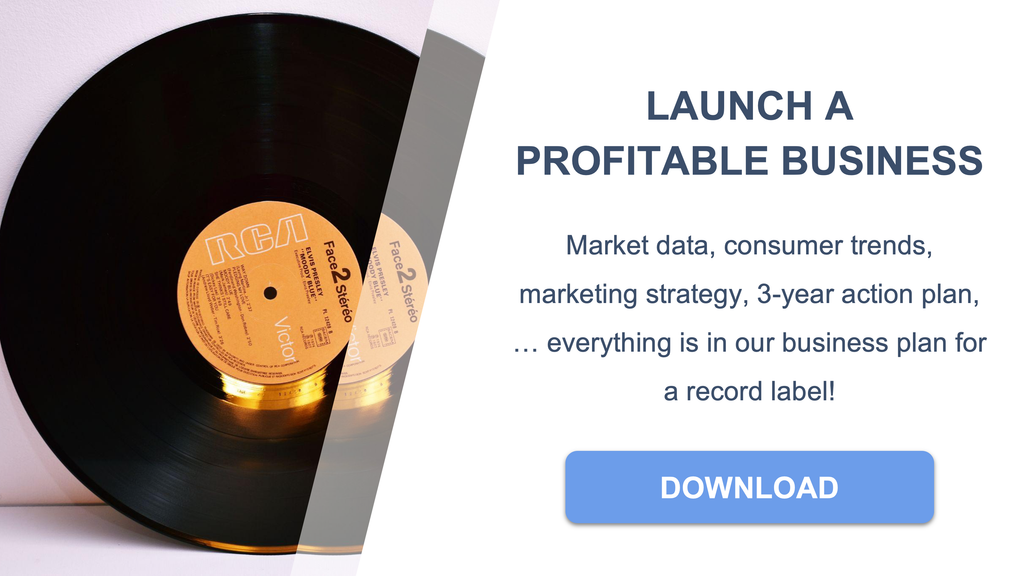This article was written by our expert who is surveying the industry and constantly updating the business plan for a record label.

Artist development is a real investment for any record label, and in 2025 it commonly requires a five- to seven-figure budget depending on scope and ambition.
Costs span signing and legal work, recording and production, videos and visuals, marketing and PR, distribution and streaming promotion, live preparation, collaborations, training, and administration—plus a contingency buffer. If you want to dig deeper and learn more, you can download our business plan for a record label. Also, before launching, get all the profit, revenue, and cost breakdowns you need for complete clarity with our record label financial forecast.
Below is an at-a-glance budget map for developing a new artist under a record label in October 2025. Figures show typical indie-to-mainstream ranges in USD and can be scaled up or down by genre, market, and release strategy.
You’ll find category percentages to help prioritize spend, plus notes you can use to tailor the plan to your label’s goals and cash cycle.
| Category | Low (USD) | Typical (USD) | High (USD) | Notes |
|---|---|---|---|---|
| Signing & Onboarding | $2,000 | $5,000–$15,000 | $30,000+ | Legal fees, contract drafting, initial admin and planning. |
| Recording (incl. mix/master) | $5,000 | $15,000–$60,000 | $120,000+ | Singles vs. full album; producers and studio tier drive variance. |
| Videos & Visuals | $3,000 | $10,000–$40,000 | $100,000+ | One main video + shortform/lyric/visualizers per release. |
| Branding & Image | $2,000 | $6,000–$20,000 | $40,000+ | Identity, photoshoots, lookbooks, styling direction. |
| Marketing & PR | $5,000 | $20,000–$120,000 | $300,000+ | Campaign waves across pre-save, launch, and sustain periods. |
| Distribution & Streaming Promo | $200 | $1,000–$6,000 | $15,000+ | Aggregator fees, playlist pitching, smart-link and pre-save tools. |
| Live Prep & Touring Support | $3,000 | $10,000–$60,000 | $250,000+ | Rehearsals, backline, crew, travel, showcases. |
| Songwriting & Collabs | $1,500 | $5,000–$25,000 | $75,000+ | Sessions, top-liners, producers; fees or points. |
| Training & Development | $1,000 | $3,000–$12,000 | $25,000+ | Vocal, stagecraft, media coaching for release windows. |
| Legal & Admin | $1,500 | $3,000–$12,000 | $25,000+ | Copyrights, licenses, PRO registrations, accounting setup. |
| Contingency (5–15%) | $2,000 | $5,000–$40,000 | $150,000+ | Overruns, rush fees, last-minute opportunities. |

What are the typical upfront costs required to sign and onboard a new artist?
Expect to budget $5,000–$15,000 for a professional signing and onboarding process at an indie label, with majors spending more for complex deals.
This covers attorney review, drafting recording and ancillary agreements, and initial business setup (tax, accounting, PRO registrations). It also includes the internal planning needed to map the first release schedule and checkpoints. You’ll find detailed market insights in our record label business plan, updated every quarter.
If you offer a cash advance, treat it as separate and recoupable from royalties; advances for emerging acts often start at low five figures when offered. Build in admin time for onboarding to digital distribution, metadata standards, and asset management.
Do not ask the artist to pay label fees; legitimate labels invest and recoup from earnings.
What budget is usually allocated for recording, mixing, and mastering an album or single?
Plan $15,000–$60,000 for a professional 8–12-track project and $800–$6,000 for a single, depending on studio tier and personnel.
Mixing commonly runs $200–$1,000 per track and mastering $75–$500 per track; producers range from fixed fees to points on revenue. Location, genre, and schedule (rush vs. standard) materially change costs.
For clarity by format and line item, see the breakdown below.
| Line Item | Typical Cost (per song) | What drives cost up/down |
|---|---|---|
| Studio time | $200–$1,200/day | Room tier, city, backline, engineer included or separate. |
| Producer fee | $500–$5,000+ | Reputation, scope (arrangement, recording, vocal production), points. |
| Session players | $200–$1,000+ | Union vs. non-union, instrumentation complexity, rehearsal needs. |
| Vocal production | $150–$800 | Tuning, comping, coaching time, engineer rate. |
| Mixing | $200–$1,000 | Mix engineer tier, revisions, stems, deadline pressure. |
| Mastering | $75–$500 | Engineer name, analog chain, deliverables (hi-res, Atmos, vinyl). |
| Misc. (edits, stems) | $50–$300 | Alt versions (radio edit, instrumental, TV mix) and stem prints. |
What are the expected costs of producing music videos and other visual content to support releases?
Budget $10,000–$40,000 for one flagship music video and $1,000–$5,000 each for supporting visualizers, shorts, and lyric videos.
Per-minute video rates from $1,500–$7,000+ are common for polished productions, while guerrilla concepts can land closer to the low end. Scope (locations, cast, VFX) and deliverables (16:9, 9:16, 1:1) drive price.
Use the table below to set expectations by format and deliverables.
| Asset Type | Typical Budget | Deliverables & cost drivers |
|---|---|---|
| Main music video | $10,000–$40,000+ | 2–3 min cut, BTS, stills; crew size, locations, lighting, permits, VFX. |
| Performance video | $3,000–$12,000 | Stage/warehouse, multi-cam, live audio capture vs. playback. |
| Lyric video | $800–$3,000 | Design complexity, typography animation, brand integration. |
| Short-form content pack | $1,500–$5,000 | 10–30 platform-native clips; editing pipeline and captioning. |
| Artwork & thumbnails | $300–$1,500 | Photographer/designer tier, concepting rounds, templates. |
| Live session (studio) | $2,000–$8,000 | Audio engineer, camera ops, color, live mix/master, room cost. |
| Visualizer pack | $1,000–$4,000 | Looping motion, brand motifs, multiple aspect ratios. |
What is the average investment in branding, styling, and image development for an artist?
Plan $6,000–$20,000 for a full brand identity and foundational image for a new artist at an indie record label.
This usually includes logo/wordmark, palette, typography, art direction guidelines, and a launch photoshoot with styling. Higher-end agency campaigns or multi-era systems can reach $30,000+.
Refresh the visual system with each campaign cycle to keep consistency while evolving the story. This is one of the strategies explained in our record label business plan.
Keep all assets in a shared library (cloud DAM) to speed production.
What are the standard costs for marketing campaigns, advertising, and PR efforts to build awareness?
Allocate $20,000–$120,000 for a multi-wave campaign (pre-save, launch, sustain) around a debut project, with mainstream ambitions requiring more.
PR retainers frequently range $2,000–$10,000+ per release cycle; paid media may add $5,000–$50,000+ depending on reach and targeting. Channel testing and iteration are essential to avoid wasting spend.
Use the table to structure spending by channel and objective.
| Channel | Typical Spend / Wave | Goal & measurement |
|---|---|---|
| PR (press/blogs/podcasts) | $2,000–$10,000+ | Coverage quality, interviews; track unique URLs, reach, and backlinks. |
| Paid social (Meta/TikTok/YouTube) | $5,000–$40,000+ | Awareness and conversion; monitor CPM, CTR, saves, pre-saves. |
| Influencer/creator seeding | $2,000–$20,000 | UGC volume and earned views; use whitelisting and creator licensing. |
| Out-of-home (select markets) | $3,000–$30,000 | Hype in touring cities; align flighting with press and shows. |
| Email/CRM & funnels | $500–$3,000 | First-party growth; track open/click rate, D2C sales, repeat engagement. |
| Radio/plugging (where relevant) | $2,000–$25,000 | Format adds; follow spins, audience, Shazam, market lift. |
| Creative production (ads/assets) | $2,000–$15,000 | Ad variants, landing pages, split-tests; shorten feedback loops. |
What budget is generally needed for digital distribution, playlist pitching, and streaming promotion?
Expect $1,000–$6,000 per release window for distribution extras, playlist pitching, and streaming growth tools beyond basic aggregator fees.
Distribution itself can be as low as $20–$50 per release, but serious playlist outreach, smart-link suites, and analytics add cost. Avoid pay-for-stream schemes; focus on credible pitching and creator integrations.
We cover this exact topic in the record label business plan. Build a repeatable pitch calendar keyed to editorial deadlines and partner submission portals.
Bundle assets (clean/instrumental/shorts) to maximize editorial use.
What are the usual expenses for live performance preparation, including rehearsals, equipment, and touring support?
Set aside $10,000–$60,000 for a showcase-to-club-run level plan, recognizing that full tours can require six figures and beyond.
Rehearsal rooms and musician fees accrue quickly, as do backline rentals, crew, and travel. Insurance, visas (if international), and per diems are essential line items.
To plan by activity and scale, use the table below.
| Line Item | Indicative Cost | Notes |
|---|---|---|
| Rehearsal studio & MD | $50–$150/hour + $500–$2,000 MD | Block bookings reduce rate; MD tightens show quickly. |
| Musicians (per show) | $150–$500+ per player | Union minimums, experience, travel days add costs. |
| Backline & tech | $500–$3,000/show | Amps, drums, wireless, playback rigs, tech support. |
| Crew (FOH, TM, LD) | $250–$800+/day each | Quality FOH/LD dramatically improves impact. |
| Travel & lodging | $1,000–$5,000+/city | Routing and advance work reduce burn. |
| Showcase costs | $3,000–$12,000 | Venue, filming, invite lists, hospitality, press. |
| Insurance & contingencies | $500–$3,000+ | Liability, equipment, cancellations, medical. |
What are the common costs for songwriting sessions, producers, and collaborations with other artists?
Budget $5,000–$25,000 across a campaign for writing camps, top-liners, and producer sessions, with high-profile collabs priced higher.
Comp structures vary: cash fees, points, or a blend; clarify splits early and register works promptly. Build a calendar of focused sessions around each release window.
Keep travel, per diems, and studio block-outs in the plan to protect creative momentum. It’s a key part of what we outline in the record label business plan.
Always document ownership, splits, and approvals before release.
What is the typical spend on training and development such as vocal coaching, stage presence, and media training?
Expect $3,000–$12,000 per year for a structured development track covering vocals, stagecraft, and media handling.
Rates of $200–$500+ per session are common with reputable coaches; plan intensives before major promo periods. Include camera sessions and mock interviews to accelerate learning.
Expand investment for choreography or complex live shows that require dancers and playback programming. Track progress with measurable goals per quarter.
Reserve time for rest and vocal health to protect the calendar.
What legal and administrative expenses should be planned for, such as contracts, licensing, and copyright registrations?
- Attorney and contract drafting for recording, publishing, and ancillary rights: $2,000–$10,000 depending on complexity.
- Copyright registrations (sound recordings and compositions), ISRC/UPC assignment, and PRO registrations: $100–$1,000+ across works.
- Licensing clearances (features, samples, artwork), plus mechanical and sync considerations as applicable.
- Accounting setup, royalty tracking software, and periodic audits to ensure accurate recoupment and payouts.
- Company admin (tax filings, insurance policies, compliance) appropriate to your jurisdiction and touring plans.
What percentage of overall costs is typically reserved for contingency or unexpected expenses in artist development?
Set aside a 5–15% contingency against the entire record label artist development budget.
Use 5–8% for tightly scoped, low-risk plans and 10–15% for higher-risk video, touring, or rush-heavy timelines. Keep it in a separate line so you can reallocate quickly when opportunities arise.
Define approval thresholds for tapping the buffer and document why it was used to refine future budgets. Get expert guidance and actionable steps inside our record label business plan.
Roll unused contingency into the next campaign wave.
What budget structure works best for digital distribution, playlist pitching, and streaming promotion?
- Create a per-release checklist with timelines for editorial submissions (DSP portals), metadata, and asset delivery.
- Allocate a core pitching budget ($500–$2,000) for trusted partners and a separate test budget for creator integrations.
- Use smart-link, pre-save, and pixel tools to build first-party audiences you can retarget across releases.
- Track save rate, playlist source streams, listener conversion to followers, and repeat listeners as primary KPIs.
- Avoid botted services; protect your catalog’s long-term health and DSP trust.
What is the realistic total cost range that a label should anticipate investing in developing a new artist in today’s market?
Indie labels commonly invest $25,000–$250,000 to launch a debut era; major-label or international ambitions often require $500,000–$2,000,000+ across multiple cycles.
A practical allocation model is: Recording 15–30%, Videos 10–20%, Marketing & PR 20–35%, Live 10–25%, Digital 5–10%, Songwriting/Production 10–15%, Branding 5–15%, Legal/Admin 3–8%, Training 3–8%, Contingency 5–15%. Calibrate by genre economics and the artist’s release cadence.
Stage funds over milestones (masters delivered, pre-save targets achieved, tour confirmed) to manage cash flow and recoupment. This is one of the many elements we break down in the record label business plan.
Use rolling forecasts so each data point from the last release improves the next one.
Conclusion
This article is for informational purposes only and should not be considered financial advice. Readers are encouraged to consult with a qualified professional before making any investment decisions. We accept no liability for any actions taken based on the information provided.
Want to build a precise budget for your label?
Explore step-by-step methods, editable templates, and financial assumptions tailored to record labels in our guides below.
Sources
- Phuong Vu — How much it costs to invest in an emerging artist
- Symphonic — Onboarding artists: what indie labels need in place
- Twine — Music production cost and prices
- Bandzoogle — Album budgeting and pre-production
- Advids — Video creation cost guide
- Synthesia — Video production cost
- MusoSoup — Music PR costs
- un:hurd — Cost of music promotion
- SoundCamps — Spotify pitching overview
- Xposure — How much does it cost to go on tour



